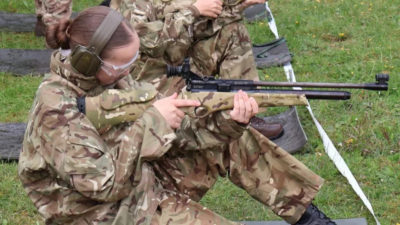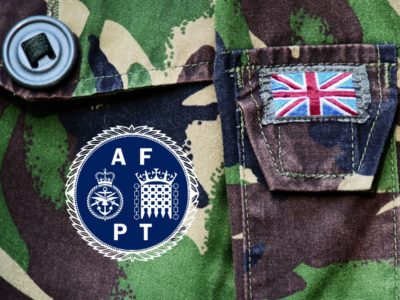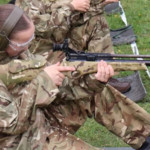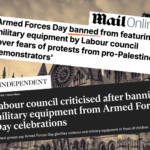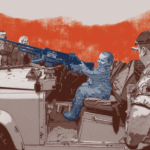Militarisation in everyday life in the UK: a conference report
ForcesWatch comment
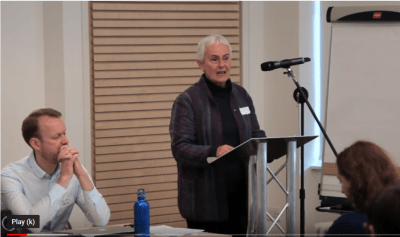
Many areas of society in the UK have seen a growing involvement and/or visibility of the military and military approaches in recent years – from schools, to local communities, to ‘militainment’ (military-themed films, TV programmes, video games etc).
This process of privileging and prioritising the military is often referred to as ‘militarisation’; Cynthia Enloe, one of the foremost thinkers on the subject, states that “To become militarised is to adopt militaristic values and priorities as one’s own, to see military solutions as particularly effective, to see the world as a dangerous place best approached with militaristic attitudes.”
In response to the recent developments in the UK, there has been an increase in critical academic studies, media coverage, and work by campaigning organisations and others on these issues. On 19 October 2013, around 70 academics, activists, campaigners, and writers came together in London at the Militarisation in Everyday Life in the UK conference organised by ForcesWatch.
The main aim of the day was to allow academics and activists to share their work and ideas, through a series of plenary presentations and group discussions, and to develop ideas on how to raise public debate and encourage critical thinking on the issues.
In the introductory plenary, the conflict transformation consultant and writer Diana Francis pointed out that war – organised lethal violence on a mass scale – is a relatively recent development in human history, asserting that we can un-learn militarism, which is closely linked to dominating structures such as patriarchy. Bryan Mabee from Queen Mary University gave an overview of militarism as something that changes over time and regionally. It is driven by nationalism (seen for example in the UK’s Armed Forces Covenant), which makes dissent very difficult, and global dynamics such as the arms trade and liberal ‘interventions’. War itself brings about transformations in terms of what preparedness for it look like which adds to the momentum of militarism. David Gee from ForcesWatch outlined current changes within the armed forces, noting current recruitment difficulties despite the apparently favourable conditions created by the financial crisis. However, he asserted that this is likely to lead to more use of drones and more privatisation of defence, and highlighted the importance of finding ways to communicate a critical analysis to a wider audience.
See here for videos of 12 presentations
The first of the two themed plenaries was on ‘Militarisation and the Individual’. In the first presentation, Falklands veteran David Jackson was interviewed by Sarah Bulmer from Exeter University – a novel and engaging approach which conveyed how a military identity is embodied, and emphasised the importance of giving veterans a voice: asking them what support they want, and challenging our assumptions about when war begins and ends. Daniel Bos, from Newcastle University explored militainment, which Roger Stahl defines as “state violence translated into an object of pleasurable consumption”, giving examples such as The Millies (The Sun’s Military Awards, which the public can nominate people for), TV programmes that give the viewer a first-person perspective of the frontline, and the armed forces’ involvement in major sporting events. He stressed that we need to analyse militainment critically, asking questions such as who was involved in its production? Emma Sangster from ForcesWatch outlined the multitude of policies and other influences that are creating an environment in which the military can increasingly ‘engage’ with young people. For example, military involvement within education is driven by two main defence outcomes: recruitment and raising awareness of the armed forces to maintain public support for them, and this is validated by the promotion of unquestioning support for the armed forces, the development of which can be traced through recent changes in policy and practice. Finally, Kevin McSorley from the University of Portsmouth, talked about militarism and the body, stressing that war is ultimately embodied – it is on bodies that war has most impact. He agreed with Catherine Lutz that militarism is often more felt than articulated, which makes it harder to think critically about it: from the continuity of bodily habit among veterans to the fact that many of us increasingly experience war through footage from soldiers’ helmet cameras.
Interesting points were raised during the group discussions and later fed back to the whole conference. On youth, it was observed that the Department for Education are once again responsible for youth services which limits the latter’s autonomy; that the National Citizen Service – with the cadets as one of the providers – has been promoted while funding for other youth projects has been cut and that we need to support non-military alternatives. The military also has a significant presence in universities. On militainment, it was acknowledged that it is hard to avoid and hard to compete with the thrill that these games and films offer, and that the links between militarised entertainment and recruitment advertising are now mainstream, but there is some encouraging work being done in developing non-military alternatives, particularly with computer games. Regarding veterans, the importance of young people hearing the varied experience of veterans before signing up was emphasised, particularly as recruiters may not give a balanced view of what’s involved in a military career. Mental health and other post-service issues and the different experiences of being a veteran need more prominence. Lastly, on the body, it was noted that bodies are increasingly viewed a a product – something to be worked on and improved – which the military fitness industry plays into. There is also an unrealistic attitude sense that war injuries can eventually be overcome. It was suggested that one response to current, often sanitised representations of warfare, would be to show more realistic portrayals of how war impacts the body.
In the second of the themed plenary sessions, ‘Militarisation and the Community’, Victoria Basham from Exeter University spoke on recent trends in the militarisation of childhood, asserting that the recruitment outcome of some of the military youth initiatives should not be overlooked, and that certain ones – such as military-led ‘alternative provision’, part of the military ethos in schools programme – are targeted at particular children: those who will get few or no academic qualifications, but who will develop a skill set very appropriate to the armed forces, where inequalities can be reproduced. She concluded that “these everyday practices have a global resonance”: the normalisation of the military and military approaches leads to military violence being seen as a commonsensical response to conflict. Vron Ware from the Open University explored the impact of Armed Forces Community Covenants which aim to promote society’s ‘moral obligation’ to the armed forces but often the focus suggests a privileging of the military rather than just removing disadvantage for members of the forces. Barnaby Pace from Scientists for Global Responsibility talked about the militarisation of ‘security’: the risks in the next 5-30 years which have been identified by the government’s own research all have non-military solutions, and yet security and defence spending is focused on hardware such as aircraft carriers and nuclear submarines; far more is spent on ‘offensive’ defence than on sustainable security solutions that address the roots of armed such as militarisation, climate change, resource competition, and economic and political marginalisation. Lastly, Ann Feltham, parliamentary spokesperson for Campaign Against Arms Trade, spoke on the privatisation of military functions, from army recruitment to the possibility that the MoD’s equipment procurement will be handed to private business. Private entities are less accountable and their primary duty is to maximise profits for their directors or shareholders.
Again, interesting points were raised during the discussions on these topics. The local communities discussion explored the impact of the community covenants on the ground and asked how involved are veterans, rather than those still in the forces, in the process; the charity Help for Heroes doesn’t help those injured pre-2001. Are the covenants, and the veterans charities, a way of the government putting the onus on society to look after ex-personnel, rather than take responsibility itself? The discussion around corporate involvement highlighted the ‘revolving door’ issue, whereby former MoD politicians or high-ranking officers go on to senior defence company jobs, and vice-versa. There is a need to challenge arguments that the arms trade is inevitable – government subsidies means it does not operate as a free market – and the argument that if the UK doesn’t supply arms, ‘someone else will’. How can the fact that the UK is making money out of war have the public resonance it deserves? Lastly, in the security discussion, it was noted that aid was itself being increasingly ‘securitised’ and that responses to root drivers of insecurity seem to be focusing on military mitigation rather than addressing the cause. In the UK, the problem of how to shift the focus away from military-related industries is not just an economic one; the industries confer an identity or status on particular areas that needs to be addressed. Concerns about the militarisation of policing – such as the proliferation of armed police, the use of drones in policing, and the recent announcement that former high-ranking armed forces officers from abroad could be hired to run police forces here – were raised.
The final plenary – ‘Working together to raise awareness and take action’ – was kicked off by Saskia Neibig, a young campaigner from the Woodcraft Folk who instigated their Military Out Of Schools campaign. She talked about her experience in challenging the development of a cadet unit in her own school and recognised the difficulties young people face in terms of choosing an alternative to armed forces activities or an armed forces career where that may be the only option. She urged people to contact and support the Woodcraft Folk campaign. Chris Rossdale from Royal Holloway University reflected on the relationship between academia and activism that challenges militarism: he stated that anti-militarism is essentially not succeeding, but that it could be strengthened by academics and activists working more closely together, and by using more accessible media to disseminate their work and stories. He added that militarism can’t be separated from other oppressive systems and social relations, and thanked the conference for taking a wide perspective on the issue. Sian Jones, a feminist nonviolent anti-militarist activist, outlined the importance of a gender analysis of militarism, and described her work with Women in Black, whose regular silent protests mourn all victims of the continuum of violence. She identified the interconnectedness of activism and research: information is always necessary to challenge successfully. Finally, Shahrar Ali, Green Party spokesperson on International Affairs, concluded the day by bringing the discussion back to the individual: how are we going to turn our awareness into action? He stressed that we have many possibilities in terms of nonviolent action.
In all, the day was a great success: the participants gave very positive feedback.
Most of the plenary presentations were filmed and can be viewed here. For more information on the conference see here.
See more: cadets, legislation & policy, militainment, military in schools/colleges, military in society, recruitment, recruitment age, remembrance, risks, veterans, war commemoration, military ethos
Like what you read?
> Sign up for our newsletter or blog notifications
> Support our work – from just £2 a month

